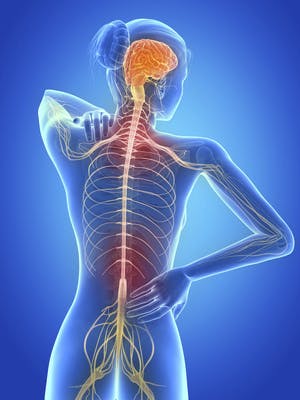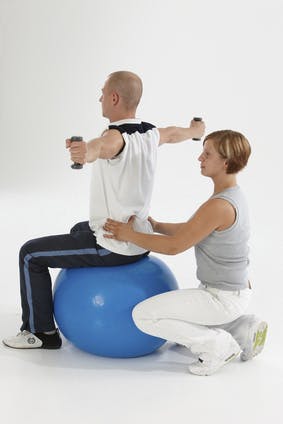Four "types" of MS have been defined and each follows a course of symptoms. Relapsing and remitting is the most common type in which new symptoms can clearly be seen and during remission few if any symptoms may be apparent.
Symptoms include weakness and numbness on either side of the body, vision disturbances and loss, and pain and tingling throughout the body. Tremors, slurred speech, dizziness and fatigue are present, along with electric shock sensations that occur with certain neck movements. Changes in temperature can make symptoms worse.
There's no cure for multiple sclerosis, but physical therapy can help:
- Strengthen muscles
- Exercise to maintain flexibility, balance and coordination
- Alleviate stiffness and spasms
- Speed recovery after an attack
- Address neurological symptoms
- Improve comfort levels
- Lessen fatigue
Clinical isolated syndrome represents the first time that symptoms are observed, but the individual may not go on to develop MS. Primary progressive MS displays steadily worsening symptoms culminating in disability. Secondary progressive MS begins with a cycle of relapsing and remitting that progress to disability.

Multiple Sclerosis, Physical Therapy and You
Many people are familiar with the term multiple sclerosis (MS), but few know just how unpredictable and disabling the disease can be. MS affects the central nervous system and disrupts the normal flow of neurological impulses between the brain and the body.
Mystery still surrounds the disease and the exact cause isn't known, making it even more frustrating for patients and their families. It may have a genetic component and be triggered by environmental elements. Women are more likely to develop multiple sclerosis than men and symptoms vary widely in type and severity.
With MS, the body's immune system begins to attack the brain, spinal cord and optic nerves. It targets myelin, a substance that surrounds the nerves. When myelin is damaged, it forms scar tissue and the damaged nerves don't transmit signals clearly from the brain to the rest of the body, resulting in a variety of symptoms.
MS is more common in temperate climates and an extensive array of viruses has been linked to MS. Smokers are more likely than non-smokers to experience symptoms of MS. Those with multiple sclerosis experience mood swings, forgetfulness and depression, along with bladder, bowel and sexual dysfunction.

Solutions for MS Challenges
Your physical therapist will focus on delaying symptoms, alleviating those you do have, and managing the disease. A specialized exercise and stretching program will be developed to address weakness in the legs and gait problems that are common in MS.
Manual manipulation and adjustment of the neck and spine help with gait and movement problems and relieves pressure on the nervous system, allowing better transmission of signals between the brain and the body. A program that includes tai-chi or yoga is helpful for breathing, flexibility, strengthening, and can be performed while sitting or standing.
The use of therapeutic massage is beneficial for improving circulation, relieving stress and inflammation, soothing the neurological system, and addressing depression. Complementary therapies may be implemented that includes acupuncture, dry needling, and hydrotherapy. Difficulty walking can be helped with gait therapy to help reduce falls and injuries, improve your stability, and increase balance and coordination.
As the symptoms of MS increase, you may find that canes, crutches, walkers or wheelchairs help improve mobility and your physical therapist can help you learn to use them effectively. Advice on nutrition and dietary supplements is available to help you stay healthy, lessen inflammation, and address any deficiencies in your diet. Your therapist can also aid you with therapies to lessen breathing difficulties.
Physical therapy can assist with all the symptoms associated with multiple sclerosis to help ease pain, reduce inflammation, and improve movement. Assistive devices, therapies to calm the neurological system, methods to delay the onset of disability, and accommodations to aid in performing everyday tasks are all available to improve your quality of life.

